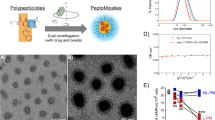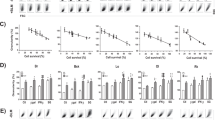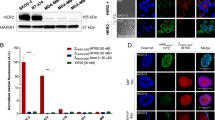Abstract
MELANOTROPIN (MSH) binds to specific receptors at the surface of mouse melanoma cells, preferentially in the G–2 phase of the cell cycle1. On prolonged incubation, a fluorescein–MSH conjugate is internalised and appears intracellularly in small vesicles2. The same phenomenon has been demonstrated by electron microscopy with an MSH–ferritin–fluorescein conjugate3. Although a role for the internalisation of MSH receptors in the execution of the hormonal message is still open to question, the fact that these conjugates of MSH are specifically recognised and internalised by melanoma cells offers a possibility for specific, site-directed chemotherapy of melanomas. We have therefore assumed that MSH–toxin conjugates might be specifically recognised and internalised and thereby have a selective toxic effect on cells that display MSH receptors on their surface. Even though the principle of site-directed chemotherapy has been known for a long time, it is only recently that this field became active4. Conjugates of specific antibodies and cytotoxic substances5–7, as well as a DNA–daunomycin complex8 have been used in an attempt to increase the selectivity of the toxic agents. In this report we describe the synthesis of a melanotropin–daunomycin conjugate and its MSH receptor mediated cytotoxic effect on mouse melanoma cells in vitro.
This is a preview of subscription content, access via your institution
Access options
Subscribe to this journal
Receive 51 print issues and online access
$199.00 per year
only $3.90 per issue
Buy this article
- Purchase on Springer Link
- Instant access to full article PDF
Prices may be subject to local taxes which are calculated during checkout
Similar content being viewed by others
References
Varga, J. M., DiPasquale, A., Pawelek, J., McGuire, J. S. & Lerner, A. B. Proc. natn. Acad. Sci. U.S.A. 71, 1590–1593 (1974).
Varga, J. M., Moellmann, G., Fritsch, P., Godawska, E. & Lerner, A. B. Proc. natn. Acad. Sci. U.S.A. 73, 559–562 (1976).
DiPasquale, A., Varga, J. M., Moellmann, G. & McGuire, J. S. J. analyt. Biochem. (in the press).
deDuve, C. in Biological Approaches to Cancer Chemotherapy (Academic, London, 1961).
Moolten, F. L. & Cooperband, S. R. Science 169, 68–70 (1970).
Mathe, G., Loc, T. B. & Bernard, J. C. r. hebd. Seac. Acad. Sci. Paris 246, 1626–1628 (1958).
Ghose, J. E. & Nigam, S. P. Cancer 29, 1398–1400 (1972).
Trouet, A., Campeneere, D. D. & deDuve, C. Nature new Biol. 239, 110–112.
Hurwitz, E. et al. Cancer Res. 35, 1175–1181 (1975).
Lande, S., Lerner, A. B. & Upton, G. V. J. biol. Chem. 240, 4259–4263 (1965).
Linden, W. A., Baisch, H., Canstein, L., König, K. & Canstein, M. Eur. J. Cancer 10, 647–651 (1974).
Varga, J. M., Saper, M. A., Lerner, A. B. & Fritsch, P. J. supramolec. Struct. 4, 45–49 (1976).
Stossel, T. P. Seminars Hematol. 12, 83–116 (1975).
Phillips, H. J. in Tissue Culture, Methods and Applications (eds Krause, P. F. & Patterson, M. K.) 406–408 (Academic, New York, 1973).
Author information
Authors and Affiliations
Rights and permissions
About this article
Cite this article
VARGA, J., ASATO, N., LANDE, S. et al. Melanotropin–daunomycin conjugate shows receptor-mediated cytotoxicity in cultured murine melanoma cells. Nature 267, 56–58 (1977). https://doi.org/10.1038/267056a0
Received:
Accepted:
Issue Date:
DOI: https://doi.org/10.1038/267056a0
This article is cited by
-
Preparation of functional liposomes with peptide ligands and their binding to cell membranes
Lipids (2000)
-
Synthesis of a novel lipopeptide with α‐melanocyte‐stimulating hormone peptide ligand and its effect on liposome stability
Lipids (1999)
-
Malignant melanoma: Targeting strategies based on α-melanocyte stimulating hormone: A review
InflammoPharmacology (1995)
-
Modulation of tumor cell gene expression and phenotype by the organspecific metastatic environment
Cancer and Metastasis Reviews (1995)
Comments
By submitting a comment you agree to abide by our Terms and Community Guidelines. If you find something abusive or that does not comply with our terms or guidelines please flag it as inappropriate.



